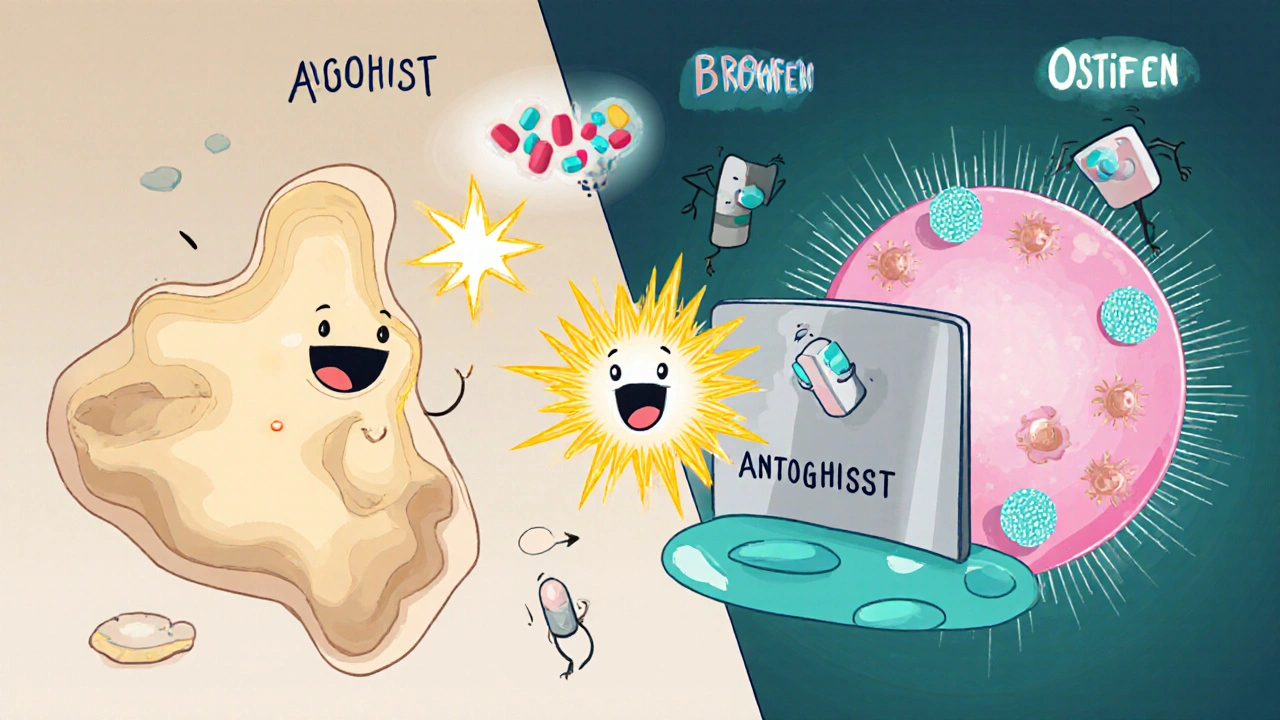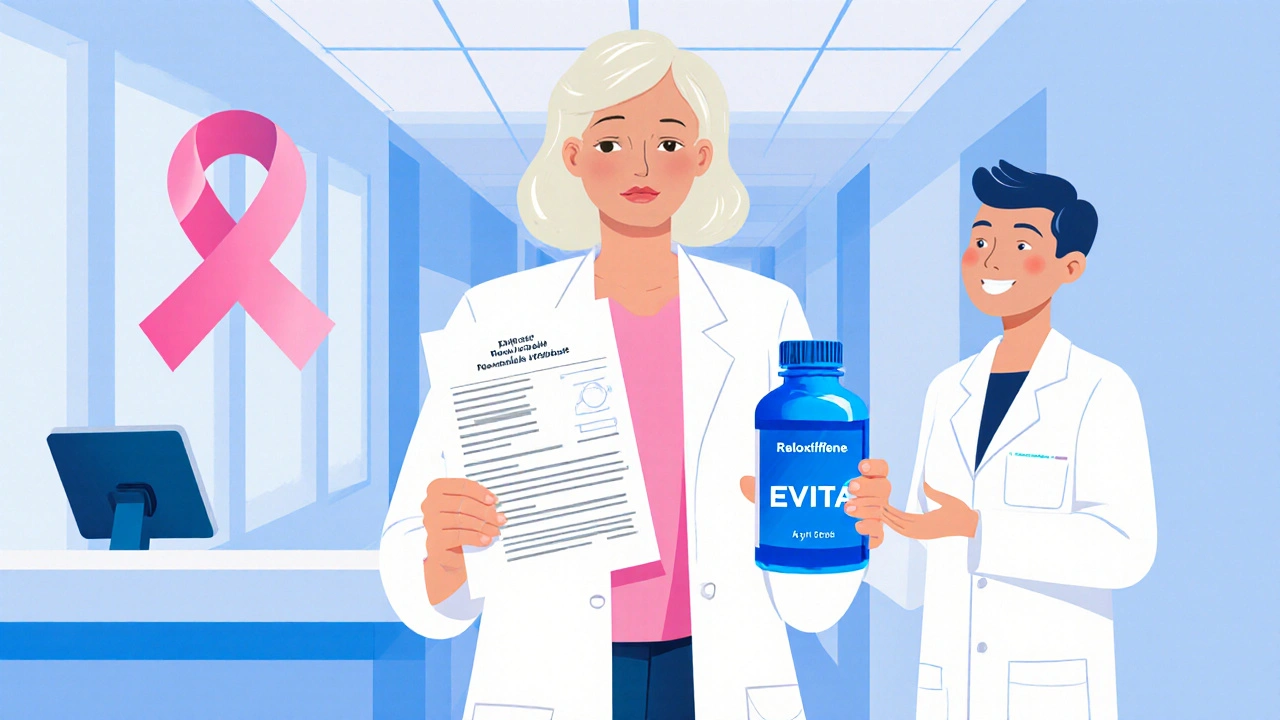Bone Health & Breast Cancer Drug Recommender
Personalized Drug Selection Tool
Select your health factors to receive tailored recommendations for bone health and breast cancer risk reduction.
Quick Summary
- Evista (Raloxifene) is a selective estrogen receptor modulator (SERM) approved for osteoporosis and breast‑cancer risk reduction.
- Top alternatives include Tamoxifen, Bazedoxifene, Hormone Replacement Therapy (HRT), Denosumab, and bisphosphonates such as Alendronate.
- Key decision factors are bone density level, menopausal status, cancer‑risk profile, side‑effect tolerance, and out‑of‑pocket cost.
- Evista shines for women who need bone protection without the uterine‑lining stimulation seen with estrogen‑based HRT.
- Consult a healthcare professional to weigh benefits against rare but serious risks like blood clots.
What Is Evista (Raloxifene)?
Evista (Raloxifene) is a third‑generation selective estrogen receptor modulator (SERM) that mimics estrogen’s positive effects on bone while blocking estrogen in breast and uterine tissue. The drug received FDA approval in 1997 for the prevention and treatment of postmenopausal osteoporosis and later for reducing invasive breast‑cancer risk in high‑risk women.
How Raloxifene Works
Raloxifene binds to estrogen receptors, acting as an agonist in bone cells (osteoblasts) and an antagonist in breast and uterine cells. This dual action improves bone mineral density (BMD) and reduces vertebral fracture risk, while simultaneously decreasing estrogen‑driven tumor growth in breast tissue.
When Doctors Prescribe Evista
- Postmenopausal women with a T‑score ≤ ‑2.5 (osteoporosis) or between ‑1.0 and ‑2.5 (low bone mass) who cannot tolerate bisphosphonates.
- Women with a heightened risk of invasive breast cancer (e.g., strong family history, previous atypical hyperplasia).
- Patients seeking a non‑hormonal option that does not increase uterine‑lining thickness.

Common Alternatives to Evista
Below are the most frequently considered drug classes when evaluating bone health or breast‑cancer risk reduction options.
- Tamoxifen - another SERM, primarily used for breast‑cancer treatment and prevention, but with a higher incidence of uterine‑lining hyperplasia.
- Bazedoxifene - a newer SERM often combined with conjugated estrogens (as the drug Duavee) for menopausal symptom relief and bone protection.
- Hormone Replacement Therapy (HRT) - estrogen ± progesterone regimens that improve bone density but carry elevated risks of breast cancer, blood clots, and stroke.
- Denosumab - a monoclonal antibody (Prolia) that inhibits RANKL, dramatically reducing bone resorption; given subcutaneously every six months.
- Alendronate - a bisphosphonate taken weekly; it binds to bone mineral and suppresses osteoclast activity.
Side‑Effect Profiles at a Glance
All medications have trade‑offs. The most relevant adverse events for each option are summarized in the table below.
| Drug | Primary Indication | Mechanism | Typical Dose | Major Side‑Effects | Cost (US $ / month) |
|---|---|---|---|---|---|
| Evista (Raloxifene) | Osteoporosis, breast‑cancer risk reduction | SERM (bone agonist, breast/uterus antagonist) | 60 mg oral daily | Hot flashes, leg cramps, rare venous thromboembolism (VTE) | ≈ $120 |
| Tamoxifen | Breast‑cancer prevention/treatment | SERM (breast antagonist, uterine agonist) | 20 mg oral daily | Endometrial hyperplasia, VTE, cataracts | ≈ $100 |
| Bazedoxifene | Postmenopausal osteoporosis (often with estrogen) | SERM (bone agonist, breast/uterus antagonist) | 20 mg oral daily | Leg cramps, abdominal pain, VTE (rare) | ≈ $130 (combo with estrogen) |
| Hormone Replacement Therapy | Menopausal symptoms, bone loss | Estrogen ± progesterone replacement | Varies (patch, pill, gel) | Breast cancer ↑, VTE ↑, stroke ↑ | ≈ $50‑$150 |
| Denosumab | Severe osteoporosis, glucocorticoid‑induced bone loss | RANKL inhibitor (anti‑resorptive) | 60 mg SC every 6 months | Hypocalcemia, infection risk, ONJ (osteonecrosis of jaw) | ≈ $500 |
| Alendronate | Osteoporosis, Paget’s disease | Bisphosphonate (osteoclast inhibition) | 70 mg oral weekly | Esophageal irritation, osteonecrosis of jaw, atypical femur fracture | ≈ $30 |
Decision‑Making Checklist
Use this quick list to see which drug aligns best with a patient’s profile.
- Bone health priority: If vertebral fracture risk is the main concern, Evista, Denosumab, and Alendronate are top choices.
- Breast‑cancer risk: For women with a high family history or prior atypical lesions, Evista or Tamoxifen provide dual protection.
- Menopausal symptoms: If hot flashes dominate, avoid SERMs (they can worsen symptoms) and consider HRT or a non‑hormonal option like low‑dose antidepressants.
- VTE history: A personal or family history of clotting disorders steers away from SERMs and HRT; Denosumab or bisphosphonates are safer.
- Kidney function: Severe renal impairment (
- Cost & insurance coverage: Generic Alendronate is the most affordable, while Denosumab and combo HRT can be pricey.
Pros and Cons of Each Option
| Evista (Raloxifene) | + Dual bone and breast‑cancer protection + No increase in uterine lining + Oral daily dosing |
- Can trigger hot flashes - VTE risk (though low) - Does not improve menopausal symptoms |
| Tamoxifen | + Strong anti‑cancer effect in breast tissue + Proven long‑term data |
- Increases risk of endometrial cancer - More severe hot flashes - Not primarily for bone health |
| Bazedoxifene | + Works well when paired with estrogen for symptom relief + Similar bone benefits to Evista |
- Limited availability in some markets - Still carries VTE warning |
| Hormone Replacement Therapy | + Improves hot flashes, mood, and bone density + Wide formulation options |
- Raises breast‑cancer risk - Higher VTE, stroke, and coronary events - Requires personalized dosing |
| Denosumab | + Powerful fracture risk reduction, especially hip + Bi‑annual injection improves adherence | - Expensive - Requires calcium & vitamin D supplementation - Risk of hypocalcemia and ONJ |
| Alendronate | + Low cost, generic availability + Strong evidence for vertebral and non‑vertebral fracture reduction |
- Gastrointestinal irritation, strict dosing rules - Rare but serious jaw osteonecrosis |
How to Talk to Your Doctor
Bring a list of your current meds, any history of blood clots, kidney function numbers, and a clear picture of your bone‑density scan. Ask specific questions:
- "How does my breast‑cancer risk influence the choice between Evista and Tamoxifen?"
- "If I develop hot flashes on a SERM, what can we do to manage them?"
- "Are there any drug‑interactions with my cholesterol medication that would affect bone‑health therapy?"
Document the doctor’s response and schedule a follow‑up DEXA scan in 12‑18 months to gauge effectiveness.
Key Takeaway: Why Evista alternatives Matter
Choosing the right bone‑health regimen isn’t one‑size‑fits‑all. For women who need osteoporosis protection **and** a safety net against estrogen‑responsive breast cancer, Evista often fits the bill. But if hot flashes dominate or clotting risk is high, alternatives like Denosumab or bisphosphonates may provide a smoother experience.
Frequently Asked Questions
Is Evista safe for women with a history of blood clots?
Evista carries a modest increase in venous thromboembolism (VTE) risk. If you’ve had a prior clot, doctors usually avoid SERMs and prefer bisphosphonates or Denosumab, which have lower clotting profiles.
Can I take Evista and calcium supplements together?
Yes. Calcium (500‑600 mg) and vitamin D (800‑1000 IU) are recommended with any osteoporosis therapy, including Evista, to maximize bone mineralization.
How does Evista compare to Tamoxifen for breast‑cancer prevention?
Both lower estrogen‑driven tumor risk, but Tamoxifen is more potent for invasive cancer prevention. However, Tamoxifen raises the chance of uterine lining thickening, while Evista does not.
Do SERMs like Evista affect cholesterol levels?
SERMs have modest effects; some studies show slight reductions in LDL cholesterol, but changes are not clinically significant for most patients.
What monitoring is required while on Evista?
Baseline DEXA scan, annual bone‑density follow‑up, and periodic assessment for VTE symptoms (leg swelling, chest pain). Liver function tests are not routinely needed.


Amanda Vallery
October 24, 2025 AT 16:03Evista's dual action makes it a solid option for postmenopaul bone health while lowering breast‑cancer risk.
Kathryn Rude
October 30, 2025 AT 07:53The essence of therapeutic choice is not merely numbers but the narrative of the body itself.
In the grand tapestry of hormonal modulation one must weigh subtle trade‑offs.
SERM’s elegance lies in its selective whisper to bone and stern veto to tumor growth.
Choose wisely, dear reader :)
Lindy Hadebe
November 5, 2025 AT 02:46Looks like another pharma hype piece.
Ekeh Lynda
November 13, 2025 AT 05:13The table of alternatives reads like a catalogue of compromises.
One must first accept that no agent is without adverse signals.
Raloxifene offers bone protection yet invites hot flashes.
Tamoxifen swaps uterine safety for breast vigilance.
Bazedoxifene entwines with estrogen, adding another variable.
Hormone therapy grants density at the expense of clot risk.
Denosumab, a monoclonal, brings injection pain and rare infections.
Alendronate, cheap, demands strict obeyance of dosing posture.
Thus the clinician becomes a balancer of risk matrices.
The patient’s values complete the equation.
Mary Mundane
November 20, 2025 AT 03:53Cost alone often decides the prescription.
Michelle Capes
November 27, 2025 AT 02:33That's a tough spot but you're not alone in figuring it out :)
I've seen folks switch when out‑of‑pocket costs climb, sometimes with a tiny typo in the pharmacy label but the outcome stays the same.
Dahmir Dennis
December 4, 2025 AT 01:13Ah, the eternal parade of “miracle” drugs that promise bone bliss while quietly whispering about clots.
Let's be honest, most patients will never read the fine print beyond “take with food”.
We glorify selective estrogen receptors as if they were saintly, yet they still parade side‑effects like a bad circus.
Imagine prescribing a SERM and then watching the patient complain of hot flashes that feel like a mini‑heatwave.
Meanwhile, the insurance company smiles at the $120 price tag and pats itself on the back.
Do we really need another headline‑grabbing comparison when the real issue is adherence?
Patients often drop the pill after a few months because the inconvenience outweighs the abstract benefit.
So before we champion Evista as the pinnacle of bone health, let's remember that real life is messy and costly.
Jacqueline Galvan
December 10, 2025 AT 23:53Indeed, the adherence challenge is a pivotal factor when selecting therapy.
Clinicians should discuss both efficacy and practical considerations such as dosing frequency and side‑effect profiles.
Evidence suggests that patients who are fully informed about potential hot flashes are more likely to persist with treatment.